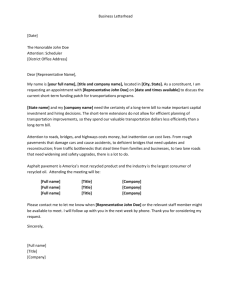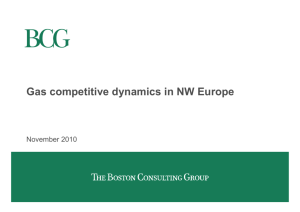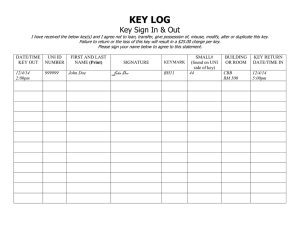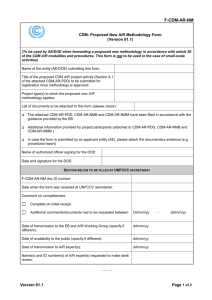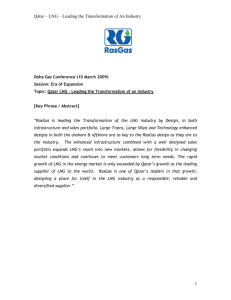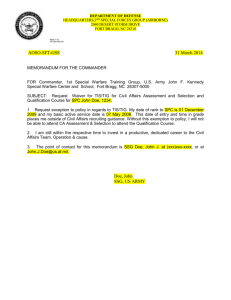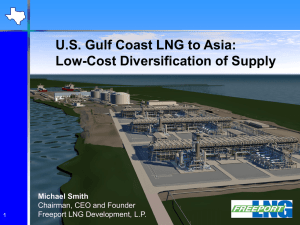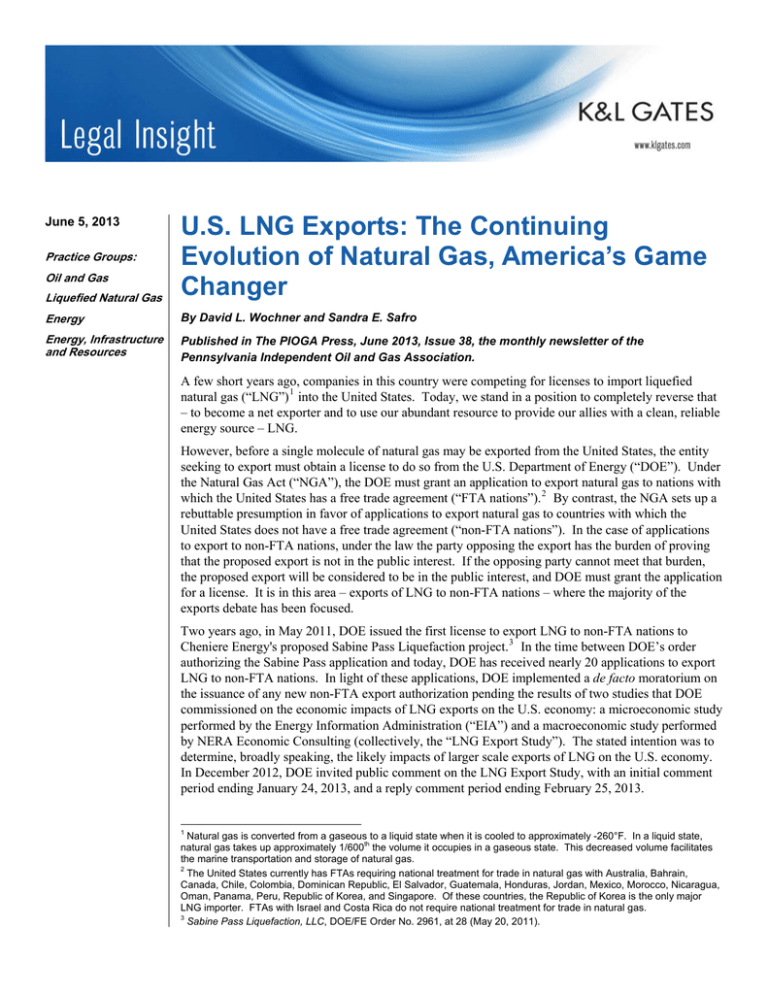
Liquefied Natural Gas
U.S. LNG Exports: The Continuing
Evolution of Natural Gas, America’s Game
Changer
Energy
By David L. Wochner and Sandra E. Safro
Energy, Infrastructure
and Resources
Published in The PIOGA Press, June 2013, Issue 38, the monthly newsletter of the
Pennsylvania Independent Oil and Gas Association.
June 5, 2013
Practice Groups:
Oil and Gas
A few short years ago, companies in this country were competing for licenses to import liquefied
natural gas (“LNG”) 1 into the United States. Today, we stand in a position to completely reverse that
– to become a net exporter and to use our abundant resource to provide our allies with a clean, reliable
energy source – LNG.
However, before a single molecule of natural gas may be exported from the United States, the entity
seeking to export must obtain a license to do so from the U.S. Department of Energy (“DOE”). Under
the Natural Gas Act (“NGA”), the DOE must grant an application to export natural gas to nations with
which the United States has a free trade agreement (“FTA nations”). 2 By contrast, the NGA sets up a
rebuttable presumption in favor of applications to export natural gas to countries with which the
United States does not have a free trade agreement (“non-FTA nations”). In the case of applications
to export to non-FTA nations, under the law the party opposing the export has the burden of proving
that the proposed export is not in the public interest. If the opposing party cannot meet that burden,
the proposed export will be considered to be in the public interest, and DOE must grant the application
for a license. It is in this area – exports of LNG to non-FTA nations – where the majority of the
exports debate has been focused.
Two years ago, in May 2011, DOE issued the first license to export LNG to non-FTA nations to
Cheniere Energy's proposed Sabine Pass Liquefaction project. 3 In the time between DOE’s order
authorizing the Sabine Pass application and today, DOE has received nearly 20 applications to export
LNG to non-FTA nations. In light of these applications, DOE implemented a de facto moratorium on
the issuance of any new non-FTA export authorization pending the results of two studies that DOE
commissioned on the economic impacts of LNG exports on the U.S. economy: a microeconomic study
performed by the Energy Information Administration (“EIA”) and a macroeconomic study performed
by NERA Economic Consulting (collectively, the “LNG Export Study”). The stated intention was to
determine, broadly speaking, the likely impacts of larger scale exports of LNG on the U.S. economy.
In December 2012, DOE invited public comment on the LNG Export Study, with an initial comment
period ending January 24, 2013, and a reply comment period ending February 25, 2013.
1
Natural gas is converted from a gaseous to a liquid state when it is cooled to approximately -260°F. In a liquid state,
th
natural gas takes up approximately 1/600 the volume it occupies in a gaseous state. This decreased volume facilitates
the marine transportation and storage of natural gas.
2
The United States currently has FTAs requiring national treatment for trade in natural gas with Australia, Bahrain,
Canada, Chile, Colombia, Dominican Republic, El Salvador, Guatemala, Honduras, Jordan, Mexico, Morocco, Nicaragua,
Oman, Panama, Peru, Republic of Korea, and Singapore. Of these countries, the Republic of Korea is the only major
LNG importer. FTAs with Israel and Costa Rica do not require national treatment for trade in natural gas.
3
Sabine Pass Liquefaction, LLC, DOE/FE Order No. 2961, at 28 (May 20, 2011).
U.S. LNG Exports: The Continuing Evolution of Natural
Gas, America’s Game Changer
On May 17, 2013, twenty-four months after it issued an order authorizing LNG exports from the
Sabine Pass LNG Terminal, DOE issued Order No. 3282, authorizing the Freeport LNG Terminal
(“Freeport”) in Quintana Island, Texas to export LNG to non-FTA nations (“Freeport Order”). 4 This
order makes Freeport the second terminal in the Lower 48 to secure such authorization.
The Freeport Order is significant because DOE not only analyzes Freeport’s application, but the
agency also analyzes the results of the LNG Export Study and the initial and reply public
comments on the LNG Export Study. Overall, DOE’s Freeport Order is a net positive for the 19
pending applications at DOE seeking authorization to export LNG to non-FTA nations and likely for
future applicants. The order demonstrates a firm understanding of the global gas market and, coupled
with recent statements from DOE officials, appears to indicate a more accelerated pace for future
orders. Importantly, DOE notes in the Freeport Order that significant LNG exports and the rapid
reversal of the natural gas market are new phenomena that are very likely to change over time.
Consequently, DOE intends to continue to monitor market developments that could tend to undermine
the public interest in grants of successive applications for exports of domestically produced LNG to
non-FTA nations.
DOE now has done the heavy lifting in terms of the actual analysis of economic factors surrounding
exports of LNG from the United States. While DOE still will need to take into account the
“cumulative impacts” for each incremental terminal it reviews, it seems to have demonstrated in the
Freeport Order that it has substantial data to rely on to justify its decision regardless of how many
applications come before it.
I. Freeport Order Will be Challenged
To start, it is important to note that DOE repeatedly has recognized that its order will be highly
scrutinized and likely will be challenged legally. Those who oppose LNG exports or have argued that
DOE should limit the volume of exports allowed very likely will file a request for rehearing, possibly
followed by a federal court appeal. The Freeport Order provides a thorough recitation and analysis of
the record. DOE not only provides its own conclusions, but in several places cites administrative law
cases that support its positions/decisions. This methodical and carefully drafted order can be viewed
as a preparation for defense of an appeal.
Under DOE’s regulations, requests for rehearing are due Monday, June 17, 2013. If DOE does not
respond to a request for rehearing within thirty days, its order will be considered final and can be
appealed. DOE, however, can provide itself with additional time to consider and respond to a request
for rehearing by issuing a tolling order within that thirty-day period. The tolling order is a procedural
mechanism and does not provide substantive analysis of a request for rehearing, nor is it a definitive
indication of how the agency ultimately will respond to a request for rehearing. Finally, once DOE
issues a final order on rehearing, parties will have sixty days to file an appeal in the U.S. Court of
Appeals for the D.C. Circuit.
II. DOE Broadens Its Consideration under the Public Interest
Standard
DOE explains in the Freeport Order that it will take a “measured approach” in reviewing other
pending applications to export LNG and laid out a detailed discussion of the factors it will be
4
Freeport LNG Expansion, L.P and FLNG Liquefaction, LLC, DOE/FE Order No. 3282, at 6 (May 17, 2013) [hereinafter
“Freeport Order”].
2
U.S. LNG Exports: The Continuing Evolution of Natural
Gas, America’s Game Changer
considering when reviewing LNG export applications. In addition to the LNG Export Study and the
initial and reply comments on it, DOE took the following other factors into consideration, including
benefits of international trade; economic impacts of higher natural gas prices and potential increases in
gas price volatility, and mitigation of same; cumulative impacts of multiple LNG export projects; and
the viability of the overall export proposal.
DOE’s comments addressing the viability of a specific proposed export project are significant and
provide a good indication of the factors that will drive DOE in a certain direction with regard to what
terminals it authorizes. Specifically, DOE’s reference to applicants’ ability to demonstrate that there
are facilities that are capable of handling the proposed export volumes clearly highlights two key
points: that DOE will give priority and/or preference to projects that are (1) brownfield terminals (i.e.,
existing import terminals), and (2) proceeding through the regulatory process at the Federal Energy
Regulatory Commission (“FERC”) 5 for authorization.
DOE also notes that it continues to subscribe to the principle set forth in its 1984 Policy Guidelines
that the market is the most efficient means of allocating natural gas supplies. DOE’s reaffirmation of
the 1984 Policy Guidelines is a very positive development for LNG exports, since the Guidelines
express a very strong preference for a market-based approach, and is one of the strongest indications
in the order that DOE will continue to process and approve succeeding applications. It notes that
agency intervention may be necessary to protect the public interest if there is insufficient domestic
natural gas supply to meet domestic needs.
III. DOE’s Processing of Pending Applications
Importantly, DOE finds that prior FTA authorizations are not a reliable predictor of the number and
capacity of LNG export facilities that will ultimately be financed, constructed, and placed in
operation. DOE concludes that prior FTA authorizations, therefore, do not undermine the
assumptions of the LNG Export Study and thus will not impact its review of pending non-FTA
applications.
In December 2012, along with its release of the LNG Export Study and solicitation of comments,
DOE issued an order of precedence for processing the pending non-FTA applications. 6 DOE officials
have publicly stated that, at least for the short term, the agency will continue to process the pending
applications in the previously announced order of precedence.
IV. DOE Supports the LNG Export Study and, in Light of Current
Conditions, Continued Exports
Overall, the Freeport Order supports the conclusions of the LNG Export Study and continued exports
of LNG. DOE finds that the conclusion of the LNG Export Study is that the United States will
experience net economic benefits from the issuance of authorizations to export domestically produced
LNG and that the LNG Export Study is fundamentally sound. The Freeport Order includes language
in multiple areas that supports continued exports. For example:
DOE takes on LNG export opponents’ arguments that natural gas confers a greater value on the U.S.
economy when used in manufacturing than when produced for export and finds that “more natural gas
5
Under the NGA, DOE has authority over exports of the natural gas commodity and FERC has authority over the siting,
construction, and operation of the LNG export facilities. FERC’s analysis includes a robust environmental review of
proposed facilities under the National Environmental Policy Act.
6
DOE Order of Precedence – Non-FTA LNG Export Applications, available at http://www.doe.gov/fe/downloads/orderprecedence-non-fta-lng-export-applications (last visited June 3, 2013).
3
U.S. LNG Exports: The Continuing Evolution of Natural
Gas, America’s Game Changer
is likely to be produced domestically if LNG exports are authorized than if they are prohibited. There
is no one-for-one trade off between gas used in manufacturing and gas diverted for export.” 7
DOE also states that it “believes that the public interest generally favors authorizing proposals to
export natural gas that have been shown to lead to net benefits to the U.S. economy. While there may
be circumstances in which the distributional consequences of an authorizing decision could be shown
to be so negative as to outweigh net positive benefits to the U.S. economy as a whole, we do not see
sufficiently compelling evidence that those circumstances are present here.” 8
DOE repeatedly finds that comments opposing Freeport’s application fail to establish that Freeport’s
proposed exports will be inconsistent with the public interest, the test that opponents must satisfy.
Due to DOE’s robust analysis of the record and consistent rejection of those comments opposing or
seeking to limit LNG exports, it seems reasonable to read DOE’s conclusions on the sufficiency of
these comments a bit more broadly to apply to other export applications in which all of the same
negative comments have been filed. In fact, not only did DOE find that the opposition had not
adequately demonstrated that exports are inconsistent with the public interest, but it could be argued
that DOE actually affirmatively demonstrates in the Freeport Order that exports are consistent with the
public interest. This affirmation should help DOE in its issuance of ensuing export authorizations for
the pending applications.
V. Supply, Demand and Gas Market Volatility
In the Freeport Order, DOE also addresses concerns raised about impacts of LNG exports on domestic
supply and demand, and natural gas market price volatility. DOE explains that, based on EIA’s
Annual Energy Outlook (“AEO”) natural gas estimates, proved reserves of natural gas, and technically
recoverable resources, there are adequate natural gas resources to meet demand associated with the
Freeport application. DOE notes, however, that these supply estimates change over time and that it
will, therefore, continue to monitor them to inform future decisions. Given ongoing production in
existing and new unconventional basins and as a result, the likely increases in technically recoverable
reserves for the next few years at a minimum, this factor should continue to be a check in the positive
column for LNG exports.
DOE disagrees, on balance, that LNG exports will substantially increase the volatility of domestic
natural gas. It explains that when domestic wholesale gas prices rise above the LNG netback price,
LNG export demand is likely to diminish, if not disappear altogether. Also, in light of DOE’s findings
that natural gas reserves are adequate to support Freeport’s proposed exports, DOE sees no reason
why LNG exports would interfere with the market’s supply response to increased prices.
Nonetheless, DOE stated that it will continue to review market information and stated in its press
release accompanying the Freeport Order that “[a]s further information becomes available at the end
of 2013, including the EIA’s Annual Energy Outlook Report, the Department will assess the impact of
any market developments on subsequent public interest determinations.”
VI. Environmental Impacts of Unconventional Production and
LNG Exports
One recurring issue raised by environmental organizations is the alleged impact on the environment
from “induced production” upstream triggered by the proposed export projects. These arguments
7
8
Freeport Order at 71.
Freeport Order at 75.
4
U.S. LNG Exports: The Continuing Evolution of Natural
Gas, America’s Game Changer
have been raised both at DOE and at FERC. Notably, DOE made little or no mention of
environmental groups’ attempts to link upstream unconventional production and hydraulic fracturing
to LNG exports. Instead, DOE explains that parties who wish to raise questions regarding the
environmental review must do so in the FERC proceedings addressing the actual import facilities.
It is a positive development that DOE has held its ground on this environmental point and continues to
defer to FERC and the robust environmental review that that agency undertakes for the export
facilities. Importantly, FERC consistently has rejected the environmental community’s efforts to link
any alleged impacts from upstream production to proposed export facilities. While a number of
challenges still remain, it appears that DOE and FERC will hold their ground on the efforts to link
upstream production with LNG exports.
Conclusion
DOE’s authorization of exports to non-FTA nations from the proposed Freeport LNG export project
should be considered a very positive development for the LNG industry. DOE’s compelling use of
supply and demand data and reliance on free market principles to reach a positive decision on LNG
exports may indicate that the agency will begin issuing non-FTA decisions on a more accelerated
basis, and thus should signal to natural gas producers in the United States that an increasing number of
global markets will be available for their game-changing resource.
Authors:
David L. Wochner
david.wochner@klgates.com
+1.202.778.9014
Sandra E. Safro
sandra.safro@klgates.com
+1.202.778.9178
Anchorage Austin Beijing Berlin Boston Brisbane Brussels Charleston Charlotte Chicago Dallas Doha Dubai Fort Worth Frankfurt
Harrisburg Hong Kong Houston London Los Angeles Melbourne Miami Milan Moscow Newark New York Orange County Palo Alto Paris
Perth Pittsburgh Portland Raleigh Research Triangle Park San Diego San Francisco São Paulo Seattle Seoul Shanghai Singapore Spokane
Sydney Taipei Tokyo Warsaw Washington, D.C. Wilmington
K&L Gates practices out of 48 fully integrated offices located in the United States, Asia, Australia, Europe, the
Middle East and South America and represents leading global corporations, growth and middle-market companies,
capital markets participants and entrepreneurs in every major industry group as well as public sector entities,
educational institutions, philanthropic organizations and individuals. For more information about K&L Gates or its
locations, practices and registrations, visit www.klgates.com.
This publication is for informational purposes and does not contain or convey legal advice. The information herein should not be used or relied upon in
regard to any particular facts or circumstances without first consulting a lawyer.
©2013 K&L Gates LLP. All Rights Reserved.
5

